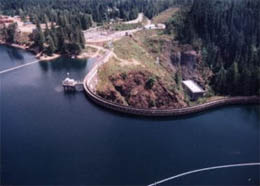On March 23, 1926, Tacoma City Light’s Cushman Dam No. 1 on the Skokomish River delivers its first electricity.
After World War I, Tacoma experienced a surge in demand for electricity to power industries and new laborsaving devices. Tacoma City Light’s Nisqually Hydroelectric Project (1912) was not enough and the private utilities would sell power only if Tacoma promised never to build any more hydroelectric projects. Public Utilities Commissioner Ira S. Davisson (1860-1951) and Tacoma City Light looked to the Skokomish River near Hood Canal on the Olympic Peninsula as the City’s next hydro project. Davisson also started construction of a tie line between Seattle and Tacoma, as well as a steam generation plant.
Acrimony Amidst Acquisitions
Acquisition of property on the Skokomish took two years of acrimonious condemnation proceedings. State fisheries board chairman Ed Sims also balked at the project and the dispute between him and the City delayed the project another year (Sims’ motives cannot be known, but this was a time when privately owned power companies overtly and covertly worked to thwart municipal hydroelectric projects).
In 1924, construction began on Cushman Dam No. 1 near Potlach. The arch design was 275 feet tall and 1,111 feet long. As many as 500 men at a time worked on the project. The two generators cranked out 32,000 kilowatts that traveled 40 miles to Tacoma by way of the real wonder of the project, the Tacoma Narrows crossing. Two pairs of 315-foot steel towers hung power cables 6,244 feet -- more than a mile -- over the windy strait.
Joyous Were the Shouts
According to Superintendent Davission, "Tense was the waiting and joyous were the shouts as the electrical energy freed by President Coolidge as he touched the key ... sent current pulsing from Washington, D.C. into the Olympic Mountains and set the huge turbines whirring" (Malloy, 88).
By 1927, a second Cushman dam and powerplant were needed. The smaller Cushman Dam No. 2 and powerhouse went online December 31, 1930.

